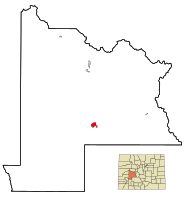Gunnison, Colorado
| City of Gunnison, Colorado | |
|---|---|
| Home Rule Municipality | |

Vienna Bakery-Johnson Restaurant in Gunnison
|
|
| Motto: "Base Camp Of The Rocky Mountains" | |
 Location in Gunnison County and the State of Colorado |
|
| Coordinates: 38°32′40″N 106°55′42″W / 38.54444°N 106.92833°WCoordinates: 38°32′40″N 106°55′42″W / 38.54444°N 106.92833°W | |
| Country | United States |
| State | Colorado |
| County | Gunnison |
| Incorporated | March 1, 1880 |
| Named for | John W. Gunnison |
| Government | |
| • Type | Home Rule Municipality |
| • Mayor | Richard Hagan |
| • City Manager | Mark Achen (interim) |
| Area | |
| • Total | 3.2 sq mi (8.3 km2) |
| • Land | 3.2 sq mi (8.3 km2) |
| • Water | 0 sq mi (0 km2) |
| Elevation | 7,703 ft (2,347 m) |
| Population (2010) | |
| • Total | 5,854 |
| • Density | 1,800/sq mi (710/km2) |
| Time zone | MST (UTC-7) |
| • Summer (DST) | MDT (UTC-6) |
| ZIP codes | 81230-81231 & 81247 |
| Area code(s) | 970 |
| FIPS code | 08-33640 |
| GNIS feature ID | 2410674 |
| Website | City of Gunnison |
The City of Gunnison is the county seat and the most populous municipality of Gunnison County, Colorado, United States. As of the 2010 census, the city had a population of 5,854. It was named in honor of John W. Gunnison, a United States Army officer who surveyed for the transcontinental railroad in 1853. Gunnison is a Home Rule municipality which reserves the right to choose how it is governed.
The town of Gunnison got its name from the first known explorer of the area, John W. Gunnison. He was searching for a route for the transcontinental railroad in 1853 and only stayed for three days before traveling west to Utah. Gunnison saw its first population increase in the 1870s, due to the mining surge throughout the state. The railroad arrived soon after in 1880 to appreciative miners, ranchers, and farmers.
In the early 1800s, the groups moving into the Gunnison area were mainly fur trappers and mountain men, trying to make a living for themselves in the rocky mountain terrain. But a drop in fur prices in the 1840s essentially cut out the need for their jobs.
The late 1850s saw the start of people joining the hunt for gold in Gunnison county. Miners were in search of placer gold, but with the growing numbers of white men in the area, this brought conflict between the Ute tribes still around the county. At least several miners were killed by these tribes and this caused some of the miners to flee the area, caring more for their lives than potential gold bonanzas.
With the mining boom, Gunnison began to see an increase of people around the 1870s. Along with the miners coming in, ranchers and farmers were among the others that lead to the Ute people becoming forced out of the area. The mining camps in Gunnison and around the county reportedly produced about 130,000 ounces of gold from the beginning of the gold rush through 1959. At the start this was mostly from placer deposits, but the largest amounts were from a by-product of silver-lead ore. The largest deposits were found along the Taylor River, as well as the Tincup and the Washington Gulch districts.
...
Wikipedia
